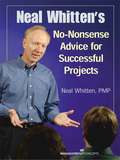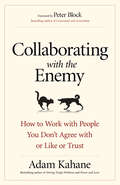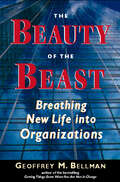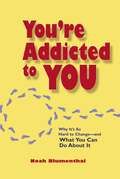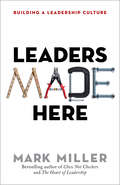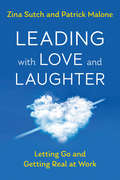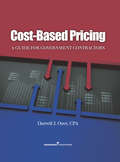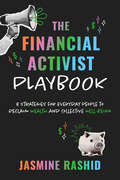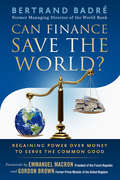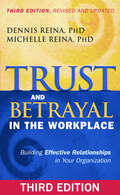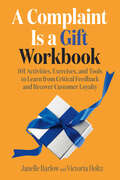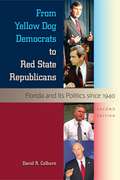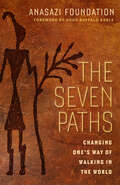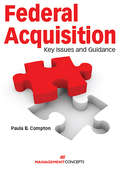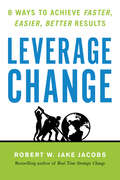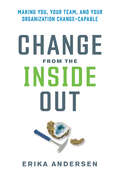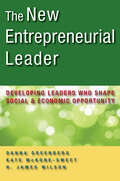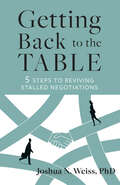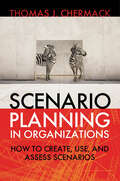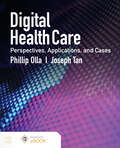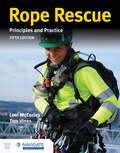- Table View
- List View
Neal Whitten's No-Nonsense Advice for Successful Projects
by Neal Whitten PMPLearn the Best Practices That Make the Difference Between Troubled Projects and Consistently Successful ProjectsThere's no better way to learn the nuts and bolts of a profession than by having a mentor at your side. But most project managers and leaders don't have that advantage — and that's why Neal Whitten wrote this book.Having Neal Whitten's No-Nonsense Advice for Successful Projects on hand is like having a mentor to guide you at every turn in the road. Neal shows you how to avoid a painful learning curve with a set of best practices for leading consistently successful projects.In this book, Neal distills his 30 years of experience into tips and strategies that are easy to learn and apply to your projects. These strategies will give you a decisive competitive edge in leading projects and working with stakeholders, clients, and team members.Learn How to:• Run your project like you'd run your own business• Become a "benevolent dictator" for the most effective leadership• Recognize and deal with professional immaturity• Deal with difficult people• Master behaviors that will make your team leaders' jobs easier andbenefit your own career• Assess if you're too soft — and learn to make unpopular decisionsif they're necessary to project success• Create a culture that fosters the success of your project• Gain the respect of your team members• Avoid making long-term project commitments• Manage to your top three problems
Collaborating with the Enemy: How to Work with People You Don’t Agree with or Like or Trust
by Adam KahaneCollaboration is increasingly difficult and increasingly necessary Often, to get something done that really matters to us, we need to work with people we don't agree with or like or trust. Adam Kahane has faced this challenge many times, working on big issues like democracy and jobs and climate change and on everyday issues in organizations and families. He has learned that our conventional understanding of collaboration—that it requires a harmonious team that agrees on where it's going, how it's going to get there, and who needs to do what—is wrong. Instead, we need a new approach to collaboration that embraces discord, experimentation, and genuine cocreation—which is exactly what Kahane provides in this groundbreaking and timely book.
The Beauty of the Beast: Breathing New Life Into Organizations
by Geoffrey M BellmanTHE WAYS WE GO about changing organizations usually don't work, asserts Geoff Bellman. Our underlying assumptions predetermine the results and preclude the broad success we so desperately seek. Change efforts often end up off-track because of small expectations. What is needed are grand expectations, so big that they cannot be realized in many lifetimes. It is only when people awaken to and work toward these immense purposes that they have the chance of finding fulfillment. Organizations are the perfect place to do this-these "beasts" which we create and curse, love and hate, that are so essential to our lives. In The Beauty of the Beast, Bellman shows how we can explore our huge potential and shift our daily organizational focus to one of long life and fulfillment-and in the process redesign our organizations for tomorrow. Bellman examines why we keep creating these creatures that fall so far short of our dreams for them. He reveals how to recognize the beast in ourselves, showing how organizational control and hierarchy multiply our natural and less constructive inclinations many times over. He points out that the problem is not the existence of organizations but in the ways we imagine them. Bellman asks us to consider what we want to pass on to future generations, helps us imagine the organizations we would be proud to create, and challenges us to take action from where we are today. He offers twenty renewal assertions to help us in redesigning organizations for tomorrow. These solid guides (with related questions for work groups) open the organization to new possibilities, helping us to embrace the organizational world as it really is while working hard to change it. In the process we will also change ourselves, as we ultimately feel less distant from-and more responsible for-creating those troubling structures we love to vent about. The Beauty of the Beast. will help people see their daily work in a new and larger perspective. It will help them embrace the real organizational world while they work at renewing it. And it will help people to recognize the choices available to them-and to exercise those choices for positive results.
You're Addicted to You: Why It's So Hard to Change - And What You Can Do about It
by Noah BlumenthalAll of us have things about ourselves we'd like to change. Maybe you want to be more organized or more outspoken, healthier or thinner. Or perhaps you want to quit smoking, work more efficiently, be a better listener, or a better leader. Whatever you want to change, you probably believe that your success depends on your conviction. The fact of the matter is, willpower alone won't get you to change. Noah Blumenthal illustrates how each of us becomes so thoroughly conditioned to act in old, counterproductive ways that negative behaviors become part of our very being. In a very real sense we become addicted to ourselves. The problem, he explains, isn't that you aren't trying hard enough, but that you've never learned the right way to make difficult changes. Here, he details a proven three-stage strategy--illuminated with practical tools, techniques, and exercises--for breaking self-addictions and conquering damaging behaviors like anger, workaholism, risk aversion, procrastination, overeating, under-exercising--just about anything. We all want to change our counterproductive behaviors. Here, Blumenthal offers a step-by-step guide for how to do it successfully.
Leaders Made Here: Building a Leadership Culture (The High Performance Series #2)
by Mark MillerLeaders Made HereGreat leaders create great organizations. However, a scarcity of leaders today means a shortfall in performance tomorrow. Don't gamble with your company's future!You don't need to hope that leaders emerge from the ranks or that search firms can find the leaders you need in a timely fashion. Hope is not a strategy! You can build an organizational culture that will ensure your leadership pipeline is full and flowing. Bestselling author and Chick-fil-A executive Mark Miller describes how to nurture leaders throughout the organization, from the front lines to the executive ranks. Leaders Made Here outlines a clear and replicable approach to creating the leadership bench every organization needs. To bring his ideas to life, Miller uses the story of Blake, a new CEO, and Charles and old friend and colleague, as they search for the best practices from around the world to ensure a continuous supply of their most precious asset – leaders. Blake and his team then translate their findings into a practical plan that any organization can use to create a leadership culture, sustained competitive advantage, and long-term success.
Leading with Love and Laughter: Letting Go and Getting Real at Work
by Patrick Malone Zina SutchLeadership has for too long been treated as a function and not as a relationship. Zina Sutch and Patrick Malone argue that successful leadership must be based on love (altruism and empathy) and laughter (positive emotions and joy).Science tells us that humans are deeply wired for empathy and compassion and that our emotional selves help us make better decisions and motivate others. However, the tactics we use to train leaders bear little reflection of these advancements; we're still creating competent but emotionally distant leaders who "manage human assets" and lead by setting goals, deadlines, and deliverables.Zina Sutch and Patrick Malone hope to flip a light switch and illuminate, above all else, that leadership begins with heart and soul. Too many training programs reduce leadership to an equation, matrix, or acronym. But leadership is a relationship. It's one human helping another. The most successful leaders show they genuinely care about their employees and are, well, fun. It's just like any relationship. In seven succinct chapters, the authors show that people lead best when they tap into their genetically driven human nature to love and nurture, connect and trust. Leading with love and laughter offers powerful dividends: tighter teams, stronger performance, improved morale, greater trust, more creativity, and even better health. While Sutch and Malone cite the science and offer examples, tips, and practices, their larger purpose is to reintroduce the warmth of human interaction and emotion as the foundation of what leadership is all about.
Cost-Based Pricing: A Guide for Government Contractors
by Darrell J. Oyer CPAThis master reference is essential if you contract with the government!Correctly pricing your goods or services—and making certain that those prices are in compliance with myriad federal rules and regulations—is essential to doing business with the government…and ensuring your commercial success. Cost-Based Pricing: A Guide for Government Contractors shows you how to appropriately estimate and price for government contracts and defend those estimates in a government contracting and subcontracting environment. This practical book includes coverage of all government pricing rules and regulations as well as pertinent aspects of related laws, such as the Truth in Negotiations Act.The book walks you through every step of the estimating process. From figuring direct labor costs to intra-company transfers to contract modifications, the coverage is extensive yet accessible for even those new to the process. Using Cost-Based Pricing, you will be able to:• Develop more realistic estimates• Enhance your support of those estimates in negotiations• Avoid violations of the Truth in Negotiations Act• Increase your chances of securing a fair and reasonable priceCost-Based Pricing: A Guide for Government Contractors can make the difference between your success—and profitability—and failure in the federal government arena.
Six Sigma for Project Managers
by Steve NeuendorfSix Sigma is a collection of ideas and tools that many organizations are using as part of their efforts to improve the quality of their products and services. Six Sigma for Project Managers explores the concepts that project managers need to know to make six sigma work for their organizations.
The Financial Activist Playbook: 8 Strategies for Everyday People to Reclaim Wealth and Collective Well-Being
by Jasmine RashidThe first and only comprehensive resource designed to empower everyday people with insider knowledge on moving money for a more equitable economy.The money myths end here. We don't need to choose between creating meaningful wealth for ourselves and our families today, or supporting social movements creating a better tomorrow. We don't all need to become certified financial "experts" to be economically empowered and make a real difference in our communities. And we're far from powerless when it comes to changing the financial system, just because we don't happen to belong to the 1%. Quite the opposite.Financial activism is how everyday people radically reimagine money as a tool for widespread well-being, instead of a weapon of absurdly increasing inequality. It's the antidote to traditional finance that evokes confusion, trauma, and (in the best-case scenario) straight-up boredom. It's how we-the underestimated-collectively resist systems that cause harm to people and the planet for the sake of profit, reclaim wealth that's been stolen, and redesign our relationships with capital and one another, in ways big and small.Going beyond tried financial literacy, The Financial Activist Playbook offers eight accessible, actionable, "choose-your-own-adventure" strategies for readers to experiment with. Drawing on timely insider knowledge from the worlds of impact investing, social justice, and more, Rashid illuminates a treasure trove of stories: demonstrating how people power can flow big bucks out of extractive industries, and into the economy of care and abundance we deserve. Playbook readers will be equipped to start visualizing and influencing the unique networks of wealth all around each of us, with strategies likeShifting collective budgets and bank dollars;Flexing our role as everyday philanthropists;Leveraging the magic of community investment;And so much more.Laced with refreshing humor, empowering exercises, and a steadfast commitment to truth-telling, Rashid takes readers on an energizing ride of financial possibility and practicality that will reverberate for generations to come.
Can Finance Save the World?: Regaining Power over Money to Serve the Common Good
by Bertrand BadréCan Finance Save the World?Regaining Power over Money to Serve the Common GoodJust as Thomas Piketty offered a sweeping critique and progressive reassessment of capitalism, former World Bank Group chief financial officer Bertrand Badré looks at the destructive role finance played in the global economic crisis of 2007–2008 and offers a bold prescription for making it a force for good. Badré says that finance is inherently neither good nor bad. It's just a tool—the most powerful tool on earth. Used correctly, it can be at the heart of the way we address many of the world's biggest problems, ranging from climate change to the eradication of poverty to building much-needed infrastructure. He describes innovations in financial tools and approaches that are already happening around the world and looks at the role regulation can play in channeling the power of finance in a positive direction. He details options for strengthening international cooperation for financial stability and prosperity and overcoming the blinkered nationalism currently on the rise. And he tells what is working and what needs to change in financing the sustainable development of the world. This book is rich with practical examples, some developed by Badré himself. For instance, he describes how at the World Bank he devised an innovative way to use insurance, a financial tool rarely considered in international development, to buttress fragile emerging economies against natural disasters and pandemics. Initiatives like these show that, as Badré writes, "when controlled and used intelligently, with benevolence and inventiveness, finance can accomplish great things."
Trust and Betrayal in the Workplace: Building Effective Relationships in Your Organization
by Dennis Reina Michelle ReinaThis new edition of a classic, bestselling book has been revised and updated throughout and includes a new chapter on Forgiveness in the Workplace
A Complaint Is a Gift Workbook: 101 Activities, Exercises, and Tools to Learn from Critical Feedback and Recover Customer Loyalty
by Janelle Barlow Victoria HoltzBased on the bestselling A Complaint Is a Gift (over 275,000 copies sold), this accompanying workbook offers actionable tools that help individuals and organizations transform even the most extreme complaints into gifts that drive their business forward.A Complaint Is a Gift introduced the revolutionary notion that customer complaints are not annoyances to be dodged, denied, or buried but are instead valuable pieces of feedback-not to mention your best bargain in market research. Complaints provide a feedback mechanism that can help organizations rapidly and inexpensively strengthen products, service style, and market focus. Most importantly, complaints that are well received create customer loyalty.Built to be interactive and immersive, the workbook teaches a set of practices, approaches, and tools that anyone can use to navigate fraught customer-facing interactions. It allows readers to practice Janelle Barlow's updated, more efficient three-step formula and enables employees to handle complaints with increased emotional resilience rather than taking them as personal attacks. A Complaint Is a Gift Workbook is packed with the necessary tools to view and treat complaints as a source of innovative ideas that can transform your business.
Historiography And Historical Method
by Directorate of Distance Education - Madurai Kamaraj UniversityThe textbook Historiography and Historical Method, part of the M.A. History First Year program at Madurai Kamaraj University, offers a comprehensive exploration into the philosophy, development, and methodology of history. It begins by probing the fundamental question, “What is history?”, and introduces learners to a wide range of historiographical traditions—from ancient Greek and Roman writings to Eastern, Arab, and Indian contributions. The text delves into key theoretical approaches such as Idealism, Historicism, Relativism, and Marx’s Dialectical Materialism. It emphasizes the historian’s role in interpretation and objectivity, and presents a rigorous framework for historical research, including heuristics, criticism, synthesis, and documentation. Additionally, it discusses whether history should be seen as an art or a science, analyzes various types of history (political, economic, social, diplomatic), and explores its integration with allied subjects like geography and political science. The book equips students not only to understand past events, but to critically analyze how history is written and used in society.
From Yellow Dog Democrats to Red State Republicans: Florida and Its Politics since 1940
by David R. ColburnLikely to raise hackles among Democrats and Republicans alike, this dynamic history of modern Florida argues that the Sunshine State has become the political and demographic future of the nation. David Colburn reveals how Florida gradually abandoned the traditions of race and personality that linked it to the Democratic Party. The book focuses particularly on the population growth and chaotic gubernatorial politics that altered the state from 1940, when it was a sleepy impoverished southern outpost, to the present and the emergence of a dominant Republican Party.
The Seven Paths: Changing One's Way of Walking in the World
by Anasazi FoundationDiscover the Healing Power of the Wilderness People have moved away from Mother Earth, bringing heartache, pain, and other maladies of the modern age. The “self-help” movement claims to offer peace and fulfillment to individuals, but this solitary approach takes us only so far. Ultimately, it is in communion with our fellow beings and the natural world that we are made whole. We need to leave the path of Me and follow the path of We. This poetic, evocative story presents the meditations of an ancient Anasazi tribesman who rejects his family and sets off on a journey through the desert. He walks seven paths, each teaching a lesson symbolized by an element of the natural world: light, wind, water, stone, plants, animals, and, finally, the unity of all beings with the Creator. The Seven Paths reveals a source of wisdom, restoration, and renewal familiar to native people but lost to the rest of us, seven elements among nature that combine to mend human hearts.
Green Deen: What Islam Teaches about Protecting the Planet
by Ibrahim Abdul-Matin“The Earth is a mosque.” Muslims are compelled by their religion to praise the Creator and to care for their community. But what is not widely known is that there are deep and long-standing connections between Islamic teachings and environmentalism. In this groundbreaking book, Ibrahim Abdul-Matin draws on research, scripture, and interviews with Muslim Americans to trace Islam’s preoccupation with humankind’s collective role as stewards of the Earth. Abdul-Matin points out that the Prophet Muhammad declared that “the Earth is a mosque.” Deen means “path” or “way” in Arabic. Abdul-Matin offers dozens of examples of how Muslims can follow, and already are following, a Green Deen in four areas: “waste, watts (energy), water, and food.” At last, people of all beliefs can appreciate the gifts and contributions that Islam and Muslims bring to the environmental movement. “Ibrahim Abdul-Matin not only shows the myriad ways American Muslims are contributing to the resolution of the environmental crisis that threatens us all but also goes a long way toward humanizing the Muslim community by sharing with the reader the lives of so many extraordinary, talented, and visionary people.” —Imam Zaid Shakir, Zaytuna College, Berkeley, California. “Ibrahim blends his passion for a green economy, his love and understanding of faith, and a deep commitment to justice in this book.” —Van Jones, founder, Green for All. “At a moment when distortions of Islam are what feed most Americans, Ibrahim Abdul-Matin has done something both practical and inspiring. He persuades us that the imperiled environment is both common struggle and common ground for people who share, it turns out, more than simply God.” —John Hockenberry, Emmy-award-winning journalist, author of Moving Violations, and host of National Public Radio’s The Takeaway.
Federal Acquisition: Key Issues and Guidance
by Paula B. ComptonTake the First Step Toward Building a Strong Foundation in Federal Acquisition!Federal Acquisition: Key Issues and Guidance is an essential guide to understanding and working within the complex world of federal government contracting. It offers brief but comprehensive explanations of the major phases and essential tasks in the contracting process. Written in a clear and easy-to-understand style, this resource provides the perfect foundation for building a thorough understanding of federal contracting.Author Paula Compton focuses on the most problematic areas of federal contracting, highlighting the deficiencies cited most often by the Government Accountability Office and Inspector General audits and reports, such as:• Not performing market research• Inadequate independent government cost estimates• Violation of the bona fide needs rule• Insufficient statements of work• Inadequate price or cost analysisAnyone new to government acquisition will find that reading this book is the ideal first step on the path to understanding the federal acquisition process. Seasoned contract professionals will find it an excellent quick review.
Leverage Change: 8 Ways to Achieve Faster, Easier, Better Results
by Robert W. JacobsFrustrated that change efforts you're leading take too long, are too difficult, or are too often ineffective? Discover eight powerful ways to make any change work faster, easier, and better—whether done by C-suite leaders or frontline workers.Organizations suffer from change fatigue. People are impatient and exhausted. They feel like too many initiatives are imposed from above or outside. They don't have time for more change and often don't even see the point in it. Wouldn't it be great if there were a systematic way to achieve your desired results in less time with fewer problems and more success? There is. It's called Leverage Change. These problems and more are resolved by what change expert Robert "Jake" Jacobs calls Levers: smart, strategic actions that create huge leverage and impact. Whether you have an existing change effort that could be turbocharged or you're launching one that's new, the Levers can help. Apply a Lever—even without a formal program—and your organization will experience positive changes. These powerful Levers, which can be used alone or in any combination that works for you, are straightforward and easy to apply:• Pay Attention to Continuity • Think and Act As If the Future Were Now! • Design It Yourself • Create a Common Database • Start with Impact, Follow the Energy • Develop a Future People Want to Call Their Own • Find Opportunities for People to Make a Meaningful Difference • Make Change-Work Part of Daily-WorkDrawing on thirty-five years of experience, Jacobs includes dozens of stories of the Levers in action with all kinds of organizations, teams, and individuals. He also provides specific directions on how you can apply them to your change work. Use the Levers, and improve your change work more than you ever imagined possible.
Change from the Inside Out: Making You, Your Team, and Your Organization Change-Capable
by Erika AndersenChange initiatives fail because humans are hardwired to return to what's worked for us in the past. This book offers a straightforward process for rewiring ourselves and those we lead to be more change-capable. Erika Andersen says avoiding change has been a historical imperative. In this book, she shows how we can overcome that reluctance and get good at making necessary change. Using a fictional story about a jewelry business changing generational hands, Andersen lays out a five-step model for addressing both this human side of change and its practical aspects: Step 1: Clarify the change and why it's needed—Get clear on what the change is and the benefits it will bring.Step 2: Envision the future state—Build a shared picture of the post-change future.Step 3: Build the change—Bring together a change team, engage key stakeholders, and plan the change.Step 4: Lead the transition—Build a transition plan that supports the human side of the change, then engage the whole organization in making the change.Step 5: Keep the change going—Work to make your organization permanently more change-capable. With opportunities to self-reflect and try out the ideas and approaches throughout, this book is a practical guide to thriving in this era of nonstop change.
The New Entrepreneurial Leader: Developing Leaders Who Shape Social and Economic Opportunity
by H. James Wilson Danna Greenberg Kate McKone-SweetIn years past, the keywords for leaders were confidence, single-minded purpose, and strategic planning. But today’s vastly complex, globalized, and fast-evolving world requires a different kind of leadership. This game-changing book details a new approach—entrepreneurial leadership—developed at Babson College, the number-one school for entrepreneurship in the world. Entrepreneurial leadership is inspired by, but is separate from, entrepreneurship. It can be applied in any organizational situation, not just start-ups. Based on two years of extensive research, it embraces three principles that add up to a fundamentally new worldview of business and a new logic of decision making. First, rapid change and increasing uncertainty require leaders to be “cognitively ambidextrous,” able to shift between traditional “prediction logic” (choosing actions based on analysis) and “creation logic” (taking action despite considerable unknowns). Guiding this different way of thinking and acting is a new view of business, where simultaneous creation of social, environmental, and economic value is the order of the day. Finally, entrepreneurial leaders leverage their understanding of themselves and their social context to guide effective action. Each chapter offers concrete examples of how educators across all disciplines are integrating these ideas into their courses—and even their entire curricula. The New Entrepreneurial Leader lays out a comprehensive new paradigm for reinventing management education in order to mold leaders who will shape social and economic opportunity.
Hello Stay Interviews, Goodbye Talent Loss: A Manager's Playbook
by Sharon Jordan-Evans Beverly KayeStay interviews prevent exit interviews! You can't afford to lose them. They're your stars and your solid citizens. You wonder if they're happy in your organization—and what might keep them there. To find out, you could:A. Conduct a survey—then try to guess who said what.B. Take note of their latest tattoos. Is your company logo among them?C. Ask, "What will keep you here?"The correct answer is C. It's the opening line of a great stay interview, and it could make the difference between keeping and losing your best people. Worried that your talented people will want things you can't deliver, like more money or a big promotion? Beverly Kaye and Sharon Jordan-Evans have a simple four-step process for dealing with that. Not sure how to get started? They provide dozens of suggested questions and icebreakers. Think you don't have time? They offer all kinds of creative time-saving options for where, when, and how you can do stay interviews.
Getting Back to the Table: 5 Steps to Reviving Stalled Negotiations
by Joshua N. WeissThe co-founder of Harvard's Global Negotiation Initiative and a renowned global guru in negotiations, presents a dynamic strategy for overcoming stalled or failed negotiations that empowers individuals to return to the table with increased strength and resilience, carefully learning from the challenges they encountered. When negotiations fail it can be hard to start over. Some people give up, others forget and move on, but the truly successful negotiator learns. Celebrated negotiation thought-leader and member of the UN Negotiations team, Joshua N. Weiss, introduces an evidence-based model for when negotiations stall or fail. Getting Back to the Table explores the reality of failure in negotiation. It lays out the types of failure that can happen, how to cope with it when it does, and how we can be resilient in the face of it. Using Weiss’s easy-to-use framework, readers can successfully get back to the negotiation table. Failing in negotiations is inevitable, but learning and growing from failure is not.
Scenario Planning in Organizations: How to Create, Use, and Assess Scenarios
by Thomas J. ChermackScenario planning helps organization leaders, executives and decision-makers envision and develop strategies for multiple possible futures instead of just one. It enables organizations to become resilient and agile, carefully calibrating their responses and adapting quickly to new circumstances in a fast-changing environment. This book is the most comprehensive treatment to date of the scenario planning process. Unlike existing books it offers a thorough discussion of the evolution and theoretical foundations of scenario planning, examining its connections to learning theory, decision-making theory, mental model theory and more. Chermack emphasizes that scenario planning is far more than a simple set of steps to follow, as so many other practice-focused books do—he addresses the subtleties and complexities of planning. And, unique among scenario planning books, he deals not just with developing different scenarios but also with applying scenarios once they have been constructed, and assessing the impact of the scenario project. Using a case study based on a real scenario project Chermack lays out a comprehensive five phase scenario planning system—project preparation, scenario exploration, scenario development, scenario implementation and project assessment. Each chapter describes specific techniques for gathering and analyzing relevant data with a particular emphasis on the use of workshops to encourage dialogue. He offers a scenario project worksheet to help readers structure and manage scenario projects as well as avoid common pitfalls, and a discussion, based in recent neurological findings, of how scenario planning helps people to overcome barriers to creative thinking. “This book is about action and performance. Compelling and thoroughly researched, it offers every business executive a playbook for including uncertainty in the organizational change process and driving competitive advantage”. -- Tim Reynolds, Vice President, Talent and Organization Effectiveness, Whirlpool Corporation
Digital Health Care: Perspectives, Applications, and Cases
by Joseph Tan Phillip OllaDigital Health Care: Perspectives, Applications, and Cases explores the trends, perspectives, and cases of Digital Healthcare and Informatics (DHI) that are transforming healthcare across the globe.Organized in 5 major connecting parts, this well-conceived text begins by laying out foundational DHI themes before focusing in on key DHI core technologies, developments, methods and challenges - from big data analytics & artificial intelligence to security and privacy issues, clinical decision support systems, consumer health informatics, and more. It then explores DHI emerging technologies (e.g. sensors and wearable electronics), and concludes with short case studies and critical case questions designed to reinforce conceptual understanding.Written for undergraduates health professionals, this accessible text offers a multidisciplinary perspective that is suitable for use in variety of healthcare disciplines-from allied health and nursing to health administration, public health, and health informatics. Each chapter follows a consistent structure that comprehensively covers a specific DHI topic(s) and related key technological components along with workplace practices from a multidisciplinary perspective.Real world cases studies (in Part 5) help students understand key and illustrate how they can been applied in real-world settings.Clinical innovations and techniques for evaluating clinical outcomes, such as improved care, performance improvement, and cost reduction in clinical settings, are explored and emphasized throughout the text.Technology and issues that a transforming the health care industry are explored including standardization, artificial intelligence (AI), cloud computing, medical sensors, enterprise architectures, and precision medicine.Navigate eBook Access (included with the printed text) provides online or offline access to the digital text from your computer, tablet, or mobile device Healthcare InformaticsHealthcare information technology Healthcare systems analysis and designInformation Systems for allied healthNursing Informatics © 2023 | 350 pages
Rope Rescue: Principles and Practice, 5e
by Loui McCurley Tom VinesRope Rescue Techniques: Principles & Practice, Fifth Edition provides comprehensive coverage of all aspects of rope rescue, including planning, PPE and equipment, medical considerations, evacuations, and special rescue operations. Based on the 2021 Edition of NFPA 1006 (Chapter 5), Standard for Technical Rescuer Professional Qualifications, the fifth edition has been significantly revised to reorganize content by Awareness, Operations, and Technician levels.Prepare to succeed in the classroom, on the training ground, and in the field.For fire and rescue professionals that want to bridge the gap between training and the field, the fifth edition reinforces proper skills performance by providing clear, visual instructions for awareness, operations, and technician level skills.A wealth of visual skill drills are included throughout to illustrate step-by-step instructions with photos for completing specific skills.New Size-up chapter helps define the role of the awareness-level rescuer in scene size-up, including how to interview witnesses to determine victim location and the scope of the incidentExpanded coverage of preplanning and hazard identification, risk assessment, and maintaining situational awarenessNew content on SMART method to developing an Incident Action Plan, hazard-specific PPE, rope systems equipment, rigging principles, and active fall protection. . © 2023 | 448 pages
